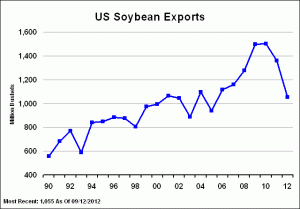Well, it is nice to be back again to the trading game. I am uploading some data for those who are trading soybeans from the website of International Grains Council at “http://www.igc.int/en/grainsupdate/igcexpprices.aspx”
|
WORLD TRADE IN SOYABEANS |
|||||||||||||||||
|
(October/September) |
|||||||||||||||||
|
m. tons |
|||||||||||||||||
| IMPORTS |
09/10 |
10/11 |
11/12 |
12/13 (f’cast) |
|||||||||||||
|
|
|
|
|
|
|
(est.) |
|
|
28.09.12 |
|
25.10.12 |
||||||
|
|
|
|
|
|
|
|
|
|
|
|
|
|
|||||
| EUROPE |
13.0 |
|
|
12.7 |
|
|
11.5 |
|
|
11.3 |
|
|
11.3 |
|
|||
| EU-27 |
12.4 |
12.2 |
11.0 |
10.8 |
10.8 |
|
|||||||||||
|
|
|||||||||||||||||
| N & C AMERICA |
4.8 |
|
|
4.8 |
|
|
4.3 |
|
|
4.4 |
|
|
4.3 |
< |
|||
| Mexico |
3.6 |
3.6 |
3.2 |
3.3 |
3.3 |
|
|||||||||||
| Others |
1.2 |
1.3 |
1.2 |
1.1 |
1.0 |
< |
|||||||||||
|
|
|||||||||||||||||
| SOUTH AMERICA |
1.2 |
|
|
0.8 |
|
|
0.7 |
|
|
1.0 |
|
|
1.0 |
|
|||
|
|
|
|
|
|
|
|
|
|
|
|
|
|
|
||||
| NEAR EAST ASIA |
4.1 |
|
|
3.1 |
|
|
2.2 |
|
|
2.9 |
|
|
2.9 |
|
|||
| Iran |
0.8 |
0.6 |
0.3 |
0.6 |
0.6 |
|
|||||||||||
| Turkey |
1.9 |
1.1 |
1.0 |
1.1 |
1.1 |
|
|||||||||||
| Others |
1.4 |
1.4 |
0.9 |
1.3 |
1.3 |
|
|||||||||||
|
|
|||||||||||||||||
| FAR EAST ASIA |
65.3 |
|
|
64.5 |
|
|
68.6 |
|
|
70.2 |
|
|
71.7 |
< |
|||
| China |
53.9 |
52.5 |
57.0 |
58.6 |
60.0 |
< |
|||||||||||
| Taipei, Chinese |
2.4 |
2.3 |
2.3 |
2.3 |
2.3 |
|
|||||||||||
| Indonesia |
1.9 |
2.1 |
1.8 |
1.9 |
1.9 |
|
|||||||||||
| Japan |
3.4 |
3.0 |
2.8 |
2.7 |
2.7 |
|
|||||||||||
| Thailand |
1.5 |
1.8 |
1.9 |
1.6 |
1.6 |
|
|||||||||||
| Others |
2.3 |
2.8 |
3.0 |
3.3 |
3.4 |
< |
|||||||||||
|
|
|||||||||||||||||
| AFRICA |
2.2 |
|
|
2.1 |
|
|
2.1 |
|
|
2.0 |
|
|
2.2 |
< |
|||
| Egypt |
1.6 |
|
|
1.6 |
|
|
1.6 |
|
|
1.5 |
|
|
1.6 |
< |
|||
| Others |
0.5 |
|
|
0.5 |
|
|
0.4 |
|
|
0.5 |
|
|
0.6 |
< |
|||
|
|
|
|
|
|
|
|
|
|
|
|
|
|
|||||
| WORLD TOTAL |
93.3 |
|
|
91.1 |
|
|
91.3 |
|
|
93.8 |
|
|
95.6 |
< |
|||
|
m. tons |
|||||||||||||||||
| EXPORTS |
09/10 |
10/11 |
11/12 |
12/13 (f’cast) |
|||||||||||||
|
|
|
|
|
|
|
(est.) |
|
|
28.09.12 |
|
25.10.12 |
||||||
|
|
|
|
|
|
|
|
|
|
|
|
|||||||
| Argentina |
13.0 |
9.2 |
7.7 |
13.2 |
11.8 |
< |
|||||||||||
| Brazil |
28.6 |
30.0 |
36.3 |
38.5 |
37.0 |
< |
|||||||||||
| Paraguay |
4.9 |
5.5 |
3.2 |
5.8 |
5.3 |
< |
|||||||||||
| USA |
41.7 |
40.2 |
37.3 |
29.2 |
34.4 |
< |
|||||||||||
| Others |
5.1 |
6.2 |
6.8 |
7.1 |
7.1 |
|
|||||||||||
|
|
|||||||||||||||||
Furthermore, I have found that the website at http://farmfutures.com is quite comprehensive for the collection of information, so one can follow news on price movements in the commodity markets. Usually I use this website for the trading as well as http://www.agrimoney.com/ website.




